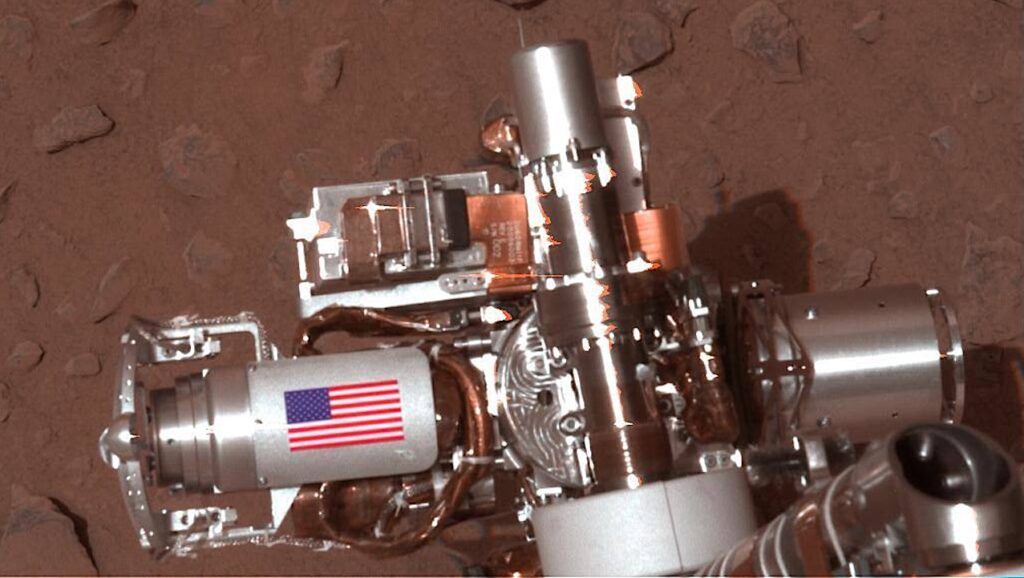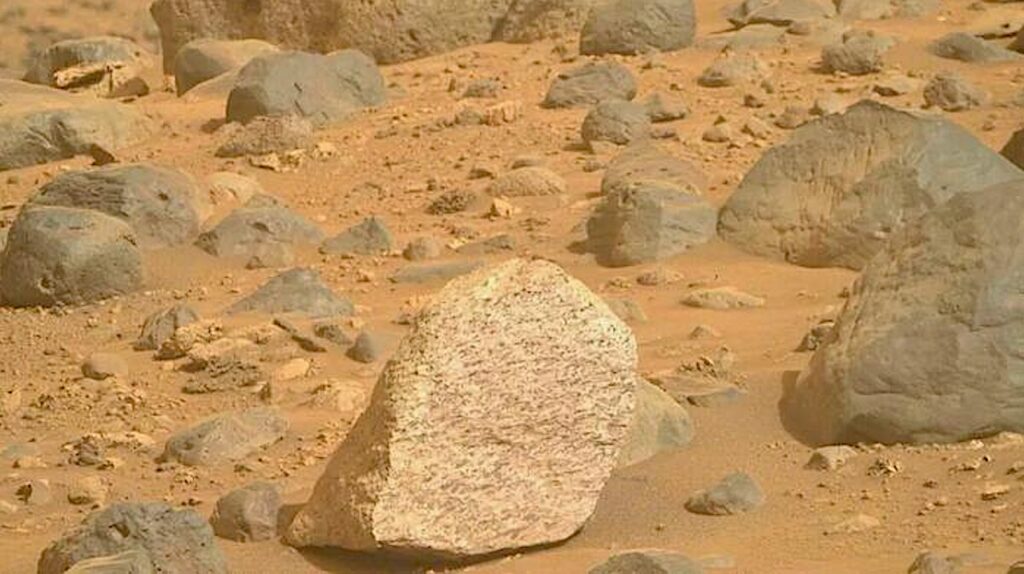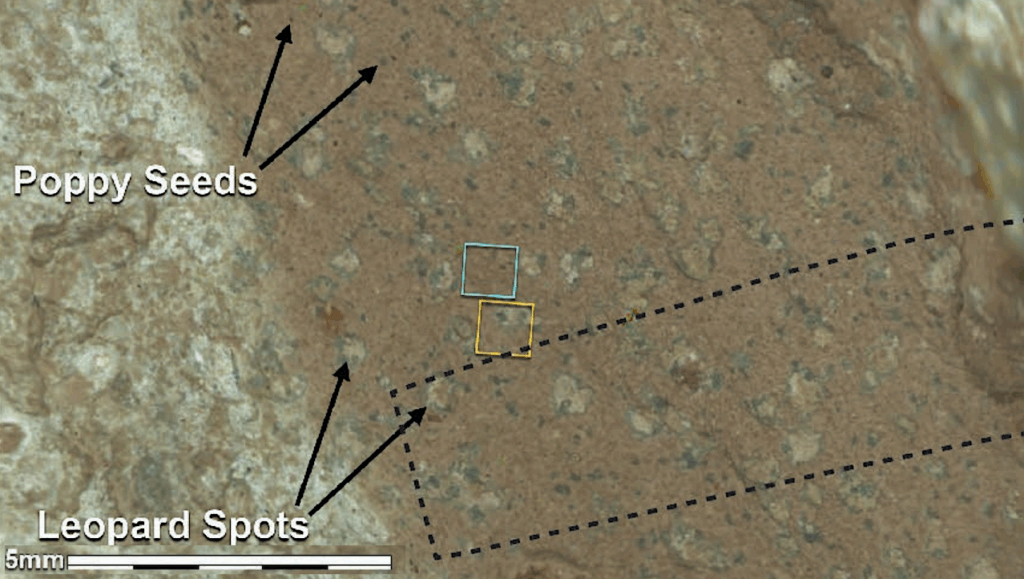Keith’s note: according to NBC “A large swath of the U.S. currently does not have the basic, ground-level immunity necessary to stop the spread of viruses that had once receded into the past, a six-month NBC News investigation in collaboration with scientists at Stanford University finds.” Given public policy ignorance that substitutes for epidemiology (Science) I can’t wait for all of the public opinion rants and arm waving about the Environmental Impact Studies for NASA Mars Sample return to Earth. That is – if that mission ever actually happens. Then it’s up to China to worry about this. Or not.
(more…)Interplanetary Memorial to Victims of Sept. 11, 2001: “The piece of metal with the American flag on it in this image of a NASA rover on Mars is made of aluminum recovered from the site of the World Trade Center towers in the weeks after their destruction. The piece serves as a cable guard for the rock abrasion tool on NASA’s Mars Exploration Rover Spirit as well as a memorial to the victims of the Sept. 11, 2001, attacks. An identical piece is on the twin rover, Opportunity. The rock abrasion tools were built by Honeybee Robotics in lower Manhattan, less than a mile from the site. This image comes from the panoramic camera on Spirit and was taken on Feb. 2, 2004, the 30th Martian day, or sol, of Spirit’s work on Mars.”
(more…)Keith’s note: I have been editing Astrobiology.com – @Astrobiology – for 30 years. I ran peer review panels for NASA Exobiology research before that. There have been a lot of “almost” announcements over the past 30 or so years – but this one is really solid. We have not found extant life on Mars – but we seem to have found remnants of something biological from Mars’ deep past aka ‘biosignatures’ – in rocks ~350 million years old which match rocks of similar ages – with biosignatures – that we find here on our own planet from Early Earth. See NASA Says Mars Rover Discovered Potential Biosignature Last Year.
(more…)Keith’s note: according to “NASA to Share Details of New Perseverance Mars Rover Finding“ there will be some Mars news – likely Astrobiology related – announced at 11 am EDT Wednesday 10 Sep. Just a guess …. from 56th LPSC a few months ago: “The Detection of a Potential Biosignature By the Perseverance Rover on Mars“ by upcoming press event participant Joel Hurowitz: “Upon entering Neretva Vallis,Perseverance investigated a set of distinct mudstone and conglomerate outcrops. We report on measurements from these rocks and describe the discovery of a potential biosignature”. Again, just a guess. Watch live here: https://www.youtube.com/watch?v=-StZggK4hhA
(more…)Keith’s note: According to “CBS News poll: Most Americans favor U.S. returning to moon, going to Mars“: “There is a lot of public favor for the idea of the U.S. returning to the moon, and also for eventually going to Mars. About two-thirds do, while a third does not. Younger Americans who are not old enough to remember the first moon landing are especially in favor, perhaps looking forward to seeing that exploration in their lifetimes. These views generally cut across ideological and party lines, as well.”
(more…)Keith’s note: According to “Slope Streaks on Mars – Not A Sign Of Water After All?” from Brown University: “A new study led by the University of Bern and Brown University in the U.S. casts doubt on one of the most tantalizing clues that water might be flowing on present-day Mars. Researchers analyzed a global database of 500,000 enigmatic streaks that occur on steep Martian slopes, concluding that they’re most likely caused by dry processes rather than liquid flow.” This could have important impacts on Mars exploration – by droids as well as humans. Remember that whole ‘water may be flowing on the surface of Mars’ thing back in 2000? (NASAWatch broke the story). People went totally crazy. Now there’s a suggestion that things are possibly different than we thought. Will NASA’s Astrobiology program mention it? Most likely not.
(more…)Keith’s 14 May note: The “skinny” FY 2026 White House budget proposal tells NASA to “reduce the space station’s crew size and onboard research”. In advance of an actual budget, NASA is already preparing to implement deep cuts. Soon. (16 May Update from NASA PAO below)
(more…)Keith’s note: According to “NASA, in surprise shift, may launch rockets to Mars next year” in Politico: “We are evaluating every opportunity, including launch windows in 2026 and 2028, to test technologies that will land humans on Mars,” said NASA spokesperson Bethany Stevens. The White House first hinted at the possibility last month in a press release after a meeting between Italian Prime Minister Giorgia Meloni and President Donald Trump. It indicated the U.S. and Italy would partner on a Mars mission as soon as next year. NASA employees who would usually know about such plans were not informed about the Mars effort prior to the White House meeting, according to a senior official, who was granted anonymity to speak about internal matters.”
(more…)Keith’s 18 April later update: NASA PAO finally started to post updates 24-36 hours after the rest of the world was reading about these discoveries everywhere except at NASA. Keith’s 17 April note: Two big Astrobiology/Space Science stories came out today based on NASA missions: JWST observations reveal possible exoplanet biosignatures (all over the news globally). Curiosity rover makes the cover of Science Magazine for carbonate discoveries on Mars. No mention of either is made at NASA.gov, astrobiology.nasa.gov, @NASA, @NASAAstroBio, or @NASASpaceSci. Everyone is worried about possible science cuts at NASA yet Public Affairs is utterly incapable of putting its own good news out for policy makers to see and consider. Baffling. Keith’s 18 April update: someone added a link about the Mars story to the NASA.gov page – but NASA Science Mission Directorate has not said anything about JWST biosignatures or Mars carbonates.
(more…)









